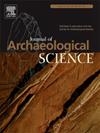用一种新的DNA微型条形码方法鉴定中国历史臼用动物胶的属源
IF 2.5
1区 地球科学
Q1 ANTHROPOLOGY
引用次数: 0
摘要
在历史建筑和绘画中,动物胶是最早也是最常用的有机粘合剂之一。这些粘合剂的鉴定将为古代人类的生活提供线索。然而,精确检测线索是具有挑战性的,因为胶水的量非常少,而且总是夹杂着其他杂质。此前,ELISA法已成功地应用于家族水平的胶水鉴定。但是,该方法不能分辨胶水的种类。例如,用酶联免疫吸附试验(ELISA)无法知道这种胶是来自牛还是羊。本研究提供了一种新的生物学技术来鉴定用作古代粘合剂的动物胶的种类。因此,采用低检出限的DNA条形码方法可以获得准确的种水平鉴定结果。此外,使用一对通用引物可以同时识别属于不同物种的10种动物胶。这些物种包括猪、牛、水牛、山羊、绵羊、骆驼、鹿、狗、马和兔子。事实上,从陕西玉林新石器时代遗址、北京紫禁城和中国山东曲阜孔庙这三个文化遗产中发现的用于砂浆的动物胶已经被成功地鉴定出来。有证据表明,当时某些动物不仅作为食物资源被食用,而且它们剩下的骨头、皮和其他部分也被用来生产动物胶。此外,我们的发现与古书中的记录一致,古书中记录了经常用于制造动物胶的动物物种。这是首次用DNA条形码方法鉴定历史砂浆中动物胶的报道。动物胶的种类鉴定不仅可以帮助考古学家了解某一地区的农业和畜牧业,而且可以帮助人们找到合适的材料进行文化遗产的修复和保护。本文章由计算机程序翻译,如有差异,请以英文原文为准。
Identify the genus origin of animal glue used in Chinese historical mortars using a new DNA mini-barcoding method
In historic buildings and paintings, animal glue was one of the first and most used organic binders. The identification of these binders would provide a clue for the life of the ancient human beings. However, the precise detection of the clue is challenging as the amount of the glue is very low and always mixed with other impurities. Previously, the ELISA method was successfully used in the identification of the glue in family level. However, the method can not tell the species of the glue. For example, it can not known whether the glue was from cattle or sheep using ELISA methods. This study provides a novel biological technique to identify the species of animal glue used as ancient binders. Hence, the accurate identification results at the species level can be obtained by DNA barcoding method with low detection limits. Moreover, ten animal glues belong to different species can be identified using a pair of universal primer at one time. These species include pigs, cattle, buffalo, goats, sheep, camels, deer, dogs, horses, and rabbits. Actually, the species of animal glue used in mortars obtained from three cultural heritages, the Neolithic Yulin City in Shaanxi Province, the Forbidden City in Beijing, and the Confucian Temple in Qufu, Shandong Province, China, were successfully identified. It was demonstrated that certain animals were not only consumed as food resource at that time, but their leftover bones, skins, and other parts were also utilized to produce animal glue. Additionally, our findings is consistent with the records in ancient books, which documented the species of animals frequently used in the manufacturing of animal glue. This is the first report using DNA barcoding method for the identification of animal glue in historic mortar. The identification of animal glue's species can not only help archaeologists understanding the agriculture and animal husbandry in certain area, but also can help people find the suitable materials for restoration and conservation of cultural heritage.
求助全文
通过发布文献求助,成功后即可免费获取论文全文。
去求助
来源期刊

Journal of Archaeological Science
地学-地球科学综合
CiteScore
6.10
自引率
7.10%
发文量
112
审稿时长
49 days
期刊介绍:
The Journal of Archaeological Science is aimed at archaeologists and scientists with particular interests in advancing the development and application of scientific techniques and methodologies to all areas of archaeology. This established monthly journal publishes focus articles, original research papers and major review articles, of wide archaeological significance. The journal provides an international forum for archaeologists and scientists from widely different scientific backgrounds who share a common interest in developing and applying scientific methods to inform major debates through improving the quality and reliability of scientific information derived from archaeological research.
 求助内容:
求助内容: 应助结果提醒方式:
应助结果提醒方式:


